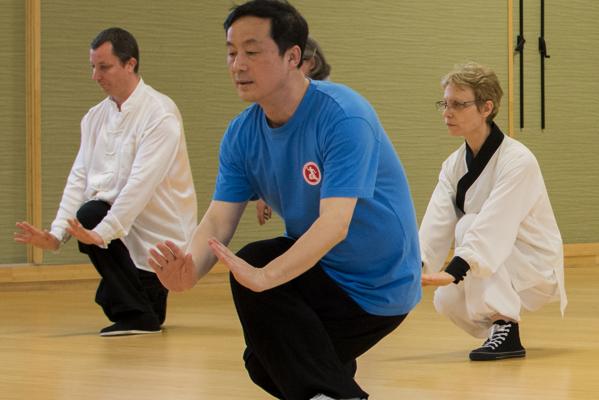
Hu Xiaofei (center), a renowned health qigong master and professor of Beijing Sport University, teaches foreign students dao yin health-keeping exercise at a workshop in Orleans, France.[Photo/China Daily]
At the entrance to the gym at Beijing Sport University’s health qigong training center, a dark plaque with the two bright Chinese characters ping jing easily draws the attention of visitors.
Literally meaning calm in English, it is a state of mind demonstrated by the slow yet smooth moves of Hu Xiaofei, founder of the center.
He demonstrates iconic health qigong gestures in accordance with breathing rhythms during training sessions every Thursday afternoon.
Hu, a health professor at BSU and renowned health qigong master, always impresses visitors with his composed approach, but he stresses the practice delivers more than the just a quiet slow-motion exercise.
“Especially those under high pressure can achieve a health status combining mental serenity and physical fitness,” Hu said. “But that only happens after long-term practice in peaceful mind.”
“Qigong is neither a kind of superstitious behavior nor a religious habit. It’s just a traditional health-maintaining exercise, which requires patience and focus.”
After studying and practicing health qigong for more than 20 years, Hu has high reputation among practitioners globally but remains modest about his contribution to its popularization.
“I just try to share my understanding of the age-old exercise with as many people as possible,” said Hu.
During the celebration of the United Nations’ 5th Chinese Language Day in April, Hu demonstrated methods and gave speeches about the exercise’s effect on fitness. Hu has earned recognition overseas, proven by his five consecutive sessions as chief judge of the International Health Qigong Tournament and Exchange from 2007 to 2013.
As the deputy director of International Health Qigong Federation’s technical committee, Hu has visited more than 20 countries and regions to train local practitioners and has taught more than 1,000 overseas students since 2000.
An Ethiopian student at BSU who started to learn traditional Chinese health-preserving methods in 2012, hails Hu as an respected and approachable mentor.
“Teacher Hu is a true master of qigong who is always keen to share his knowledge with us without hesitation,” said the 25-year-old.
“He’s so patient when explaining us what it is and its difference from wushu or other forms of traditional Chinese exercise. His training helps me clear up many misunderstandings of the practice.”
Forms of health qigong
With the development of modern science, traditional health qigong is evolving into new forms to meet the needs of modern society. The Chinese Health Qigong Association has organized experts to create five major exercise methods of health qigong based on traditions as follows:
Yi jinjing, derived from Zen
Yi jinjing is a health-building method created by Chinese Zen Buddhism founder Bodhidharma for the purpose of exercising muscles and tendons.
It emphasizes turning, bending, extending and stretching of muscles, bones and joints.
The flexible postures, mental focus and breathing frequency required by yi jinjing fit the needs of people in different fitness conditions of all ages.
Regular practice has a positive effect on improving the functions of the cardiovascular, respiratory and digestive systems, raising the balancing ability, bettering flexibility and strength of muscles and tendons.
Wu qin xi, or five-animal frolic
Wu qin xi is a method developed by famed ancient Chinese doctor Hua Tuo in the Eastern Han Dynasty (25-220) by imitating the actions of five kinds of animals — the tiger, deer, bear, ape and bird.
By emulating animals, the movements of wu qin xi are gentle yet powerful.
Its intensity of physical exercise fits most of the people.
Long-term practice can help cardiopulmonary functions, the respiratory system and joint agility as well as the psychological condition.
Ba duan jin, or eight-piece brocade
Ba duan jin emerged before the Song Dynasty (960-1279) and developed into a formal exercise in the Ming and Qing dynasties (1368-1911). Its name refers to how eight individual movements in the form characterize and impart the smooth-moving quality of a piece of brocade.
As a whole, it is broken down into eight separate exercises, each focusing on a different physical area.
It traditionally contains both a standing and seated set of eight postures each.
It helps build up the immune function, raise the ability to resist senility and enhance the nervous system after long-term practice.
Liu zi jue, or six-sound healing
The earliest record of liu zi jue can be found in the documents of the Northern and Southern Dynasty (420-581).
It is an breathing exercise producing six different sounds together with a certain set of slow-motion body movements.
By making the six vocal sounds, it is believed the function of internal organs will be coordinated with outside of the body.
This set is a very calming routine and is an excellent qigong form to work in the evening. It helps shed the tensions of the day, calming the body and mind, leading to more restful sleep.
Tai ji yang sheng zhang, inspired by taiji
The mace is a type of apparatus in traditional Chinese regimens long used in physical exercise.
Tai ji yang sheng zhang is based on the ideas of taiji — the unity of yin and yang. It features practice with apparatus-guided limb movements together with respiration and meditation as the major approaches. The method can be either practiced as a whole or divided into individual routines or combinations of multiple routines.
